The older brother helped 5-years-old Arisha to build it.
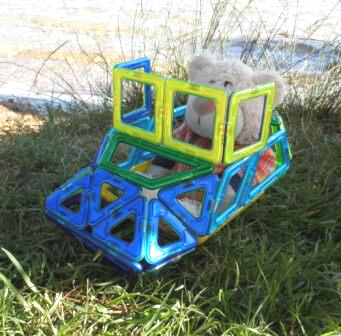
The older brother helped 5-years-old Arisha to build it.

All the basic Gakken waffle pieces we have.
Unlike Plus Plus waffle blocks, Gakken blocks have pieces of many different shapes. They have round and curved pieces, long beams and H-like pieces. The empty spaces inside the blocks also can have different sizes and shapes, so you can stack inside different pieces in different positions. All this allows even more building possibilities than the waffle blocks sets with similar pieces. However, some pieces have less connection opgtions, because they don’t have pegs on the sides, or have only one hole.
Gakken brand appeared in Tokyo back in 1946 when it became an important component of Japan’s post-war efforts to rebuild the nation. Back then, it became incredible important to properly raise a new generation that will be able to create a better future.
The founder and educator, Hideto Furuoka, created first basic Gakken waffle pieces. He later told that his inspiration was traditional Japanese wooden houses. There he saw an idea of flat blocks people can took apart and rebuild again when they need to. So he decided to create a toy which repeats this principle. Children can connect these Japanese waffle building blocks, stack them, lay them, plug, or tuck blocks in different orientations, for example, horizontally, vertically, and diagonally.
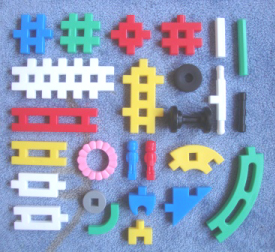
A big summer house with a chimney. It actually looks nice in this scenery. Available for rent!
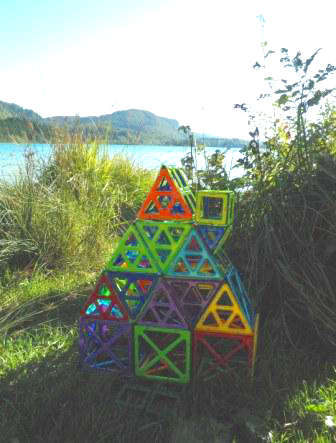
Along with the solid panels, Pythagoras has openwork sets like this one. The pieces look light and hollow, but their connection principle is exactly the same. We made each cube from these polygons, and then a whole Pythagoras city.
Pythagoras, Tiko, and Tako are vintage building sets. They have big panels of different colors and shapes, that connect by the edges. Each piece has sockets and balls that can snap together, connecting the pieces. You can also connect the pieces of different shapes, as long as their sides match. This connection is strong enough to hold even the biggest structures together.
Because of the sockets’ form, Pythagoras and Tiko panels can form both flat surfaces and 3D shapes. The flexible joint connection means that you can connect the pieces at different angles. The bigger panels are huge – they are a few inches long, so kids can create toy hats or items to hold, and not just toys. They are sturdy enough to wear and to play with. There also are smaller pieces that can help connect the bigger pannels together or make smaller crafts. The pieces of this set have all kinds of shapes – there are different triangles, rectangles, squares, pentagons, and so on, all in different colors.
Sadly, Amazon seemingly has no sets exactly like Tiko and Pythagoras, but some very similar concepts also are interesting enough.

The new set of Magna-Tiles is ice. Absolutely transparent details – squares of 2 sizes, triangles of 3 types. You can build a palace, a wall, a dog, anything, and everything will be transparent, like ice.
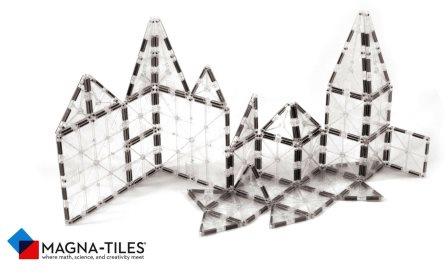
Magnetic-flavoured summer ice cream. Very colorful, but not very tasty.
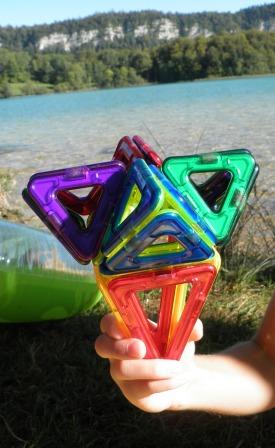
And the ice dog. A design proposed by Magna-Tiles.
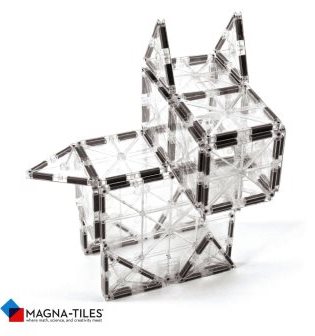
Alesya uses Magformers as a geometric mosaic. Our heating batteries are covered with large metal screens, on which you can lay out any magnetic compositions. In winter, of course, it is not very convenient – the screens are hot, but Alesya likes it anyway. Different heroes live in the houses (in this case, 3 dogs), and she tells some stories about them with the involvement of additional figurines on magnets.

The largest set of the Japanese blocks Gakken contains not only cockpits for a car and an airplane, but also spare parts for a dinosaur. There are large paws (we used them in the tank – below), a head, and a tail. The set also has 4 animals – polar bear, lion, giraffe and pink elephant. There are also little people available – 2 blue boys and 2 red girls. They are very small and very Japanese.
Unlike Plus Plus waffle blocks, Gakken blocks have pieces of many different shapes. They have round and curved pieces, long beams and H-like pieces. The empty spaces inside the blocks also can have different sizes and shapes, so you can stack inside different pieces in different positions. All this allows even more building possibilities than the waffle blocks sets with similar pieces. However, some pieces have less connection opgtions, because they don’t have pegs on the sides, or have only one hole.
Gakken brand appeared in Tokyo back in 1946 when it became an important component of Japan’s post-war efforts to rebuild the nation. Back then, it became incredible important to properly raise a new generation that will be able to create a better future.
The founder and educator, Hideto Furuoka, created first Japanese blocks Gakken. He later told that his inspiration was traditional Japanese wooden houses. There he saw an idea of flat blocks people can took apart and rebuild again when they need to. So he decided to create a toy which repeats this principle. Children can connect these Japanese waffle building blocks, stack them, lay them, plug, or tuck blocks in different orientations, for example, horizontally, vertically, and diagonally.

Geomag My Castle – cardboard pictures from the set.
